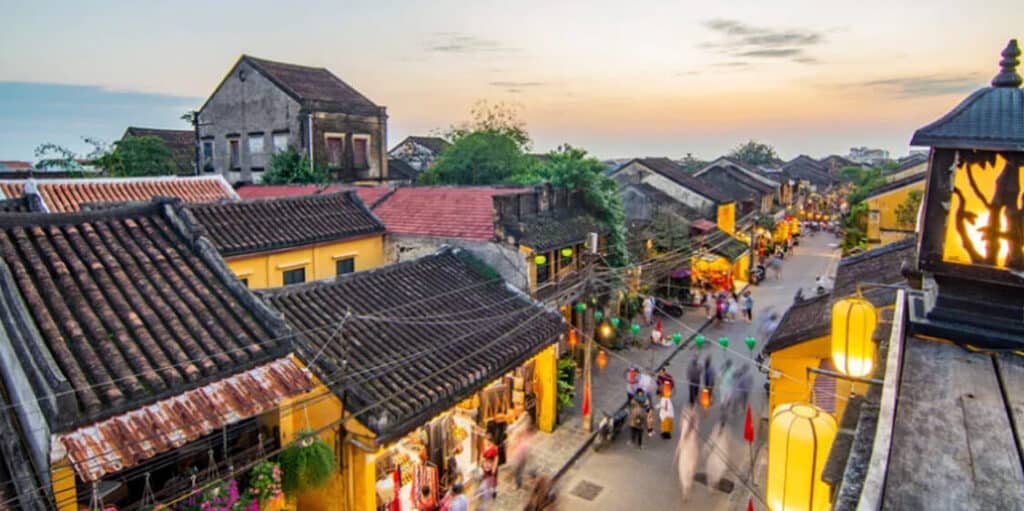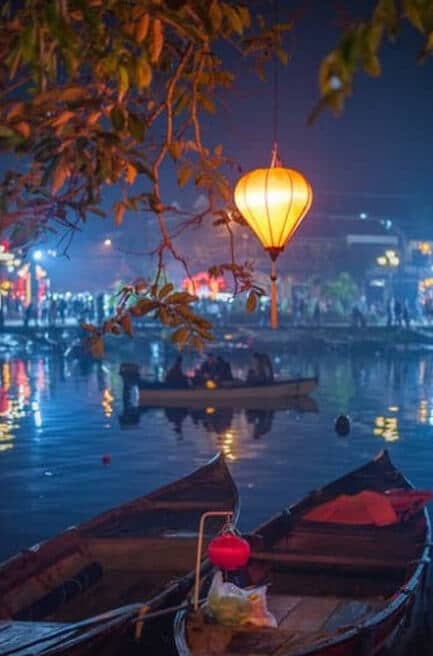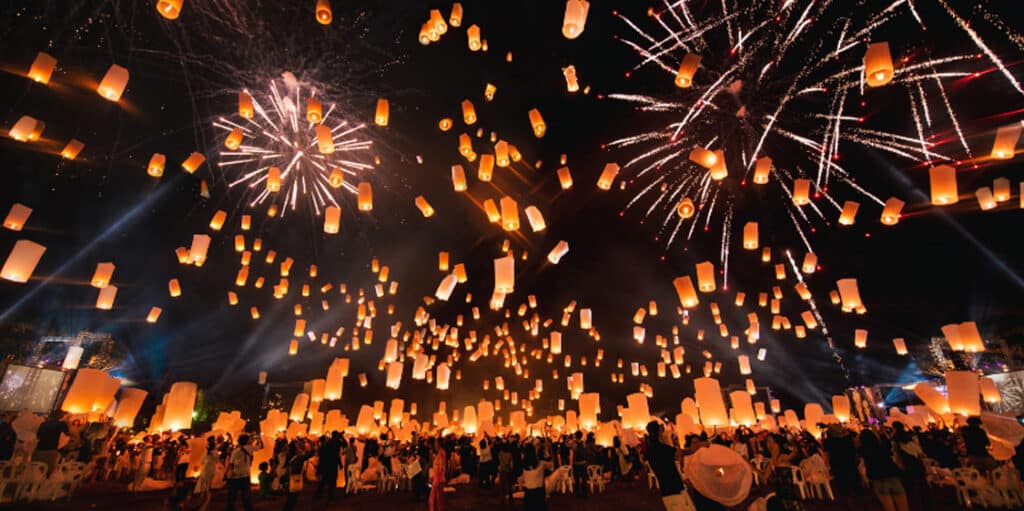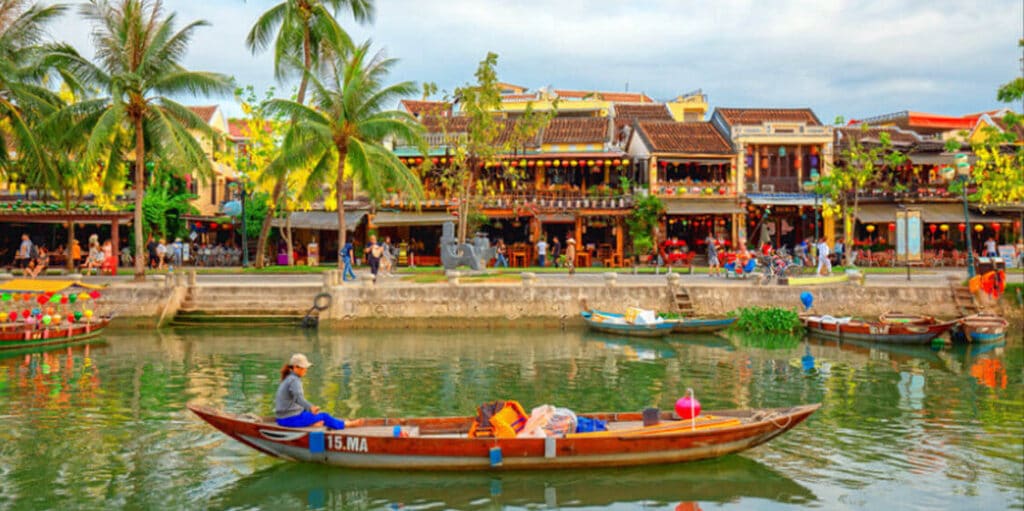On the picturesque central coast of Vietnam lies a town that seems to have defied the relentless march of time. Welcome to Hoi An, a place where history, culture, and beauty converge to create an enchanting destination that has captivated travelers from across the globe. Known as the “City of Lanterns” and a UNESCO World Heritage Site, Hoi An is a testament to the enduring allure of Southeast Asia and is revered for its rich tapestry of history, vibrant traditions, and a warm-hearted community that welcomes you with open arms.

The name “Hoi An” itself carries a whisper of the past. In Vietnamese, “Hoi” means “meeting place,” while “An” translates to “peace.” This moniker is profoundly fitting for a town that has been a gathering point for cultures, merchants, and travelers for over 2,000 years. Hoi An’s history can be traced back to ancient Champa Kingdom, but it flourished during the 16th and 17th centuries as a bustling trading port under the name “Faifo.” It was here that seafarers from Europe, Asia, and beyond would converge to exchange goods, ideas, and cultures.
Location that Paints a Postcard
Hoi An’s geographical location is nothing short of breathtaking. It sits on the banks of the serene Thu Bon River, approximately 30 kilometers south of Da Nang, Vietnam’s third-largest city. This prime location offers not only stunning river views but also easy access to pristine beaches, lush countryside, and nearby mountains. The town’s proximity to Da Nang International Airport makes it a convenient entry point for travelers looking to explore the region.
The People: Keepers of Tradition and Warm Welcomes
What truly sets Hoi An apart is its people, who embody the essence of Vietnamese warmth and hospitality. The locals, known as Hoi An’s “living treasures,” take immense pride in preserving their cultural heritage. Their warm smiles and genuine enthusiasm for sharing their traditions with visitors create an immediate sense of belonging.
The town’s population is an eclectic mix of ethnic Vietnamese, Chinese, and Cham descendants, each contributing to Hoi An’s unique tapestry. The residents continue to celebrate their heritage through colorful festivals, ancient rituals, and the skilled craftsmanship that has made Hoi An famous for tailoring, lantern making, and traditional cuisine.
Recent History: The Path to Preservation
While Hoi An’s history is a colorful tapestry of cultures intertwining, its more recent past tells a story of preservation and revitalization. In the 19th century, as trade routes shifted and the Thu Bon River silted up, Hoi An’s importance as a trading hub waned. The town, once a bustling international port, seemed to fade into the mists of time.
However, it was this relative isolation that became Hoi An’s saving grace. Unscathed by the ravages of war, the town retained much of its original architecture and charm. In 1999, Hoi An was recognized as a UNESCO World Heritage Site, prompting efforts to safeguard its unique heritage. Today, strict regulations govern the preservation of the town’s historic buildings and streets, ensuring that its timeless beauty continues to enchant visitors.
A Glimpse into Hoi An as an Asia Holiday Destination
Hoi An is more than just a tourist destination; it’s an immersive experience that invites travelers to step back in time and savor the authentic flavors of Vietnam’s cultural heritage. Here’s a brief insight into why Hoi An should be at the top of your Asia holiday list:
Historical Enchantment: Walking through Hoi An is like stepping onto a movie set from a bygone era. The meticulously preserved architecture, ancient streets, and lantern-lit evenings transport you to another time.
Culinary Heaven: Hoi An is a food lover’s paradise. The town is renowned for its delectable street food, culinary classes, and unique dishes like “Cao Lau” and “White Rose Dumplings.”
Artistry and Craftsmanship: Explore the town’s vibrant art scene, watch artisans at work, and immerse yourself in the craft culture that has been honed for centuries.
Cultural Celebrations: Witness Hoi An come alive during festivals like the Hoi An Lantern Festival, where thousands of colorful lanterns illuminate the streets and the river.
Tailoring and Souvenirs: Get custom-tailored clothing, leather goods, and souvenirs crafted to your specifications at Hoi An’s renowned tailor shops.
Natural Wonders: Explore the stunning nearby attractions, from the tranquil An Bang Beach to the verdant rice paddies of Tra Que Village.
Warmth and Hospitality: Experience the genuine warmth of the locals, who take pride in sharing their traditions and stories with visitors.
In essence, Hoi An is more than just a place; it’s a journey back in time, a celebration of heritage, and an opportunity to create cherished memories in one of Asia’s most captivating destinations. Whether you’re wandering through ancient streets adorned with lanterns, savoring exquisite cuisine, or simply basking in the tranquility of the Thu Bon River, Hoi An promises an experience that will stay with you long after you’ve left its enchanting embrace.

Hanoi Vietnam

Must-Visit Attractions
Must-Visit Attractions and Landmarks in Hoi An:
Hoi An’s Charm Beckons: A Spartan’s Guide to Must-Visit Spots
When in Hoi An, every cobblestone street whispers tales of centuries gone by. This ancient town, bathed in the soft glow of lanterns, offers a glimpse into Vietnam’s rich history and culture. From preserved architectural marvels to vibrant markets and serene beaches, Hoi An presents a treasure trove of attractions for intrepid travelers:
Hoi An Ancient Town: Step into a living museum where historic buildings, adorned with lanterns, tell stories of Hoi An’s past. Explore the Japanese Covered Bridge, Tan Ky Old House, and the Assembly Halls for a journey through time.
An Bang Beach: Seek solace on the sandy shores of An Bang, a tranquil beach located a short bike ride from the town center. Enjoy the sun, sea, and fresh seafood at beachfront cafes.
My Son Sanctuary: Venture into the mystical realm of My Son, an ancient Hindu temple complex dating back to the 4th century. It’s a UNESCO World Heritage Site and a testament to Vietnam’s rich spiritual heritage.
Hoi An Night Market: As twilight descends, the town transforms into a bustling marketplace. Stroll along the river, where vendors peddle handicrafts, clothing, and street food. Don’t forget to haggle!
Tra Que Vegetable Village: Immerse yourself in the rural charm of Tra Que, a village where time seems to stand still. Witness traditional farming methods and savor farm-to-table cuisine.

How to Get To Hoi An
Embark on the Odyssey to Hoi An:
Arriving in Hoi An is akin to stepping into a fairy tale. While this charming town doesn’t have an airport, getting here is part of the adventure. Here’s how to make your way to this enchanting destination:
Fly to Da Nang: The closest major city to Hoi An is Da Nang. Da Nang International Airport welcomes flights from major Vietnamese cities like Hanoi and Ho Chi Minh City, as well as international destinations.
Da Nang to Hoi An: From Da Nang, you have several transportation options to reach Hoi An:
- Private Transfer: Arrange a private car or van to take you directly to Hoi An, which is about a 30-minute drive away.
- Taxi: Taxis are readily available at the airport, but make sure they use a meter or agree on a fare beforehand.
- Shuttle Bus: Various shuttle bus services operate between Da Nang and Hoi An, offering a budget-friendly option.
- Grab or Ride-Sharing Apps: Utilize Grab, a popular ride-sharing app in Vietnam, to book a ride to Hoi An.
- Public Bus: The local bus, while the cheapest option, can be a bit challenging due to language barriers and crowded conditions.
Best Time To Go Hoi An
Chasing Seasons in Hoi An: A Guide to Timing
Hoi An’s climate is as diverse as its attractions, making it a year-round destination. However, understanding the seasons can enhance your visit:
-
Dry Season (February to August): This period is ideal for exploring Hoi An, with sunny days and pleasant temperatures. The dry season aligns with many local festivals, offering a cultural immersion.
-
Rainy Season (September to January): While the occasional downpour can be refreshing, heavy rains and flooding are possible. However, this time of year has its own charm, with fewer tourists and lush landscapes.
-
Festivals: Plan your visit around Hoi An’s enchanting lantern festivals. The most famous is the Full Moon Lantern Festival, which occurs on the 14th day of each lunar month.

Best Way To Get Around
Navigating Hoi An’s Winding Streets:
Hoi An is a pedestrian-friendly town where the best way to explore is on foot. However, when you need to venture a bit further, several options await:
Walking: Most attractions in Hoi An are within walking distance of each other, especially in the ancient town. Stroll along the lantern-lit streets, taking in the historic ambiance.
Bicycles: Rent a bicycle to explore the town and nearby countryside at your own pace. It’s an eco-friendly and leisurely way to discover the region.
Motorbike Taxi (Xe Om): For short trips or when you need a lift with your shopping, hop on the back of a motorbike taxi. Negotiate the fare beforehand.
Boat: To explore the serene Thu Bon River or visit nearby islands, consider taking a boat tour. It’s a unique perspective of Hoi An.
Rental Scooters: If you’re confident in your scooter-riding skills, renting one can be convenient for exploring areas beyond the town center.
Off the Beaten Path Hidden Gems
Unveiling Hoi An’s Hidden Charms: A Seeker’s Quest
While Hoi An’s main attractions are captivating, delving into its hidden gems can uncover treasures few travelers encounter:
Kim Bong Carpentry Village: Just across the river, Kim Bong Village is a sanctuary of wooden craftsmanship. Watch artisans at work and learn about traditional woodworking techniques.
Cam Thanh Coconut Village: Paddle through the tranquil waterways of Cam Thanh in a traditional basket boat. This hidden gem immerses you in the region’s lush nature and authentic culture.
Thanh Ha Pottery Village: Discover the art of pottery in Thanh Ha Village, where you can try your hand at molding clay and painting ceramics.
Co Co Riverside Market: Escape the tourist crowds at this local market, where you can sample authentic Vietnamese dishes and mingle with friendly locals.
Phuoc Lam Pagoda: Nestled in the countryside, this serene pagoda offers a peaceful retreat from the town’s hustle and bustle.

Local Cuisine / Best Restaurants?
Hoi An’s Culinary Odyssey:
Hoi An’s culinary scene is a mesmerizing tapestry of flavors, drawing inspiration from Vietnam’s diverse regions. Savoring local cuisine is an integral part of your journey:
Cao Lau: This iconic dish features chewy noodles, roast pork, and local greens. Try it at one of the street food stalls or restaurants in the ancient town.
Banh Mi Phuong: Hoi An’s famous banh mi is a must-try. Visit Banh Mi Phuong, made famous by Anthony Bourdain, for mouthwatering sandwiches.
White Rose Dumplings: Sample these delicate, translucent shrimp dumplings at White Rose Restaurant, where they’ve been perfected for generations.
Com Ga (Chicken Rice): Delight in tender chicken served with fragrant rice and herbs. Restaurants like Com Ga Ba Buoi are renowned for this dish.
Quang Noodle: Taste Quang-style noodles, a local specialty. Central Market is an excellent spot to try this dish among locals.
Hoi An Roastery: For coffee enthusiasts, Hoi An Roastery serves some of the best brews in town.
Morning Glory: This renowned restaurant offers a diverse menu of Vietnamese dishes, prepared to perfection.
Activities in Hoi An
Adventures Await in Hoi An: An Explorers Activity Guide
Hoi An offers a diverse range of activities for every traveler:
Hoi An Lantern Making: Join a lantern-making workshop to create your colorful masterpiece and immerse yourself in local craftsmanship.
Thu Bon River Boat Tour: Explore the serene river by taking a traditional wooden boat tour. Opt for a sunset cruise for a magical experience.
Hoi An Cooking Classes: Learn to prepare traditional Vietnamese dishes in a cooking class. You’ll shop for ingredients at a local market and cook under expert guidance.
Bike Tours: Explore the surrounding countryside on a bicycle tour, visiting rural villages and scenic landscapes.
Basket Boat Tour: Take a basket boat tour in Cam Thanh Village, where you’ll navigate narrow waterways and learn about traditional fishing methods.
Japanese Bridge Illumination: Witness the Japanese Covered Bridge illuminated with lanterns during the full moon, a mesmerizing spectacle.
Unique Cultural Experiences
Immerse yourself in Vietnamese culture with these unique Hoi An experiences that let you embrace Hoi An’s Rich Culture:
Full Moon Lantern Festival: If your visit aligns with a full moon, join the enchanting Full Moon Lantern Festival, where the entire town is adorned with colorful lanterns.
My Son Sanctuary Ritual: Witness a Cham dance performance at My Son Sanctuary, offering insight into the region’s ancient spirituality.
Tailor-Made Clothing: Hoi An is renowned for its tailors. Have custom-made clothing created just for you, from suits and dresses to shoes and accessories.
Language
Local Language of Hoi An
Unlocking Local Connections: A Language Crash Course
Conversing in Hoi An: Bridging the Cultural Divide
In the heart of Hoi An, where the ancient meets the contemporary, the key to unlocking deeper connections with locals often lies in the power of language. While English is widely spoken in tourist areas, embracing a few Vietnamese phrases can elevate your experience from pleasant to profound:
Xin chào (Sin chow): Hello
Why it Matters: A warm “Xin chào” is your passport to initiating conversations and making friendly introductions. It’s the verbal equivalent of a welcoming smile, the universal language of camaraderie.
In Action: Greet the local shopkeeper with a cheerful “Xin chào!” as you step into their quaint boutique. Witness the transformation from a simple transaction to an exchange of pleasantries that brightens both your days.
Cảm ơn (Gahm uhn): Thank you
Why it Matters: Gratitude is a universal language of its own. When you express appreciation in Vietnamese, you’re acknowledging not just the service but the rich tapestry of culture that accompanies it.
In Action: Picture yourself at a bustling street food stall, savoring a bowl of delectable Cao Lau noodles. As you pay and nod your thanks with a heartfelt “Cảm ơn,” you’re forging a connection with the local chef who’s delighted to share their culinary heritage with you.
Bao nhiêu tiền? (Bow nyew tyen): How much does this cost?
Why it Matters: Bargaining is an art form in many Asian markets, and this phrase becomes your brushstroke. It’s your way of signaling that you’re not just a visitor but an enthusiastic participant in the vibrant local scene.
In Action: Amid the bustling Hoi An Night Market, you spot an exquisite piece of handmade jewelry. With a friendly “Bao nhiêu tiền?” you embark on a playful banter with the artisan, adding a dash of negotiation to your shopping experience.
Một bia, xin (Moht bee-uh, sin): One beer, please
Why it Matters: Beyond a simple order, this phrase signifies your readiness to immerse yourself in the local customs and savor the flavors of Vietnam, one “bia” (beer) at a time.
In Action: Imagine sitting by the Thu Bon River, a traditional Vietnamese boat drifting gently in the water. As you raise your glass and request “Một bia, xin,” you’re celebrating the simplicity and joy of life along the banks of Hoi An.
In Hoi An, every spoken word transcends language, weaving a tapestry of shared moments, and creating bonds that linger long after your visit. With these simple phrases, you’ll not only navigate the city but also navigate hearts, leaving behind a trail of genuine connections and unforgettable memories.
Accommodation in Hoi An
Finding Your Haven in Hoi An: An Accommodation Guide
Choosing the Perfect Abode Amidst Hoi An’s Timeless Beauty
Hoi An’s allure isn’t limited to its ancient streets and vibrant culture; it extends to the diverse range of accommodations that cater to every traveler’s needs and desires. Here’s your guide to finding your haven in this enchanting town:
1. Boutique Hotels: Anantara Hoi An Resort and Hotel Royal Hoi An
Immerse in the Town’s Charm: Hoi An’s essence lies in its historic quarters, and boutique hotels like Anantara Hoi An Resort and Hotel Royal Hoi An seamlessly blend with this narrative. Imagine waking up in a room adorned with local artwork, stepping out onto a balcony that offers a glimpse of the bustling streets, and savoring breakfast amidst colonial-era architecture.
Exclusive Comfort: These boutique gems are designed to pamper you with luxurious amenities, serene courtyards, and world-class dining. Unwind by the pool or indulge in a spa treatment, and let the town’s timeless charm seep into your soul.
2. Riverside Retreats: Almanity Hoi An Wellness Resort and Little Riverside Hoi An
Picturesque River Views: Hoi An’s soul flows with the Thu Bon River, and staying at riverside retreats like Almanity Hoi An Wellness Resort and Little Riverside Hoi An means waking up to breathtaking water vistas. Your room becomes a canvas, with each sunrise painting a new masterpiece.
Wellness and Tranquility: These retreats offer more than just a room; they provide wellness experiences that harmonize with Hoi An’s serene ambiance. From rejuvenating spa treatments to yoga by the river, your stay becomes a journey of holistic healing.
3. Budget Hostels: Tribee Hostel and Under The Coconut Tree Hostel
Vibrant Atmosphere on a Budget: For the spirited traveler who values experiences over extravagance, Hoi An’s budget hostels like Tribee Hostel and Under The Coconut Tree Hostel offer much more than a place to sleep. They provide a lively atmosphere where friendships are forged over travel tales and local beers.
Community Spirit: These hostels often organize activities like communal dinners, cultural exchanges, and guided tours, fostering a sense of community among travelers from around the world.
4. Homestays: Hoi An Homestay and Hoi An River Palm Homestay
A Glimpse into Local Life: Perhaps the most immersive way to experience Hoi An is by staying with local families in traditional homes or guesthouses. Hoi An Homestay and Hoi An River Palm Homestay open their doors to travelers seeking an authentic connection.
Home Away from Home: Expect warm hospitality, home-cooked meals, and insightful conversations about Hoi An’s history and culture. These homestays become more than just a place to sleep; they become an integral part of your Hoi An narrative.
Whether you seek opulent luxury, tranquil riverside serenity, budget-friendly camaraderie, or an authentic local experience, Hoi An’s accommodations ensure that your haven matches your desires. In this town where time seems to stand still, your choice of accommodation becomes the backdrop to your own timeless tale.
Ha Long Bay Vietnam
How's the weather in Hoi An?
Cracking the Code of Hoi An’s Climate: Some Weather Wisdom
Understanding Hoi An’s weather patterns can help you plan your trip effectively:
Dry Season (February to August): Enjoy sunny days and pleasant temperatures, ideal for sightseeing and outdoor activities.
Rainy Season (September to January): Expect occasional heavy rains, which can create a serene atmosphere and fewer crowds.
Recommended Itinerary
1 Week in Hoi An
A week in Hoi An allows you to delve deep into its enchantments while taking leisurely strides:
Day 1-2: Explore Hoi An Ancient Town
- Wander through the historic streets and visit the Japanese Covered Bridge, Tan Ky Old House, and Assembly Halls.
- Experience the Full Moon Lantern Festival if your visit coincides with it.
Day 3: My Son Sanctuary Excursion
- Embark on a day trip to My Son Sanctuary, exploring ancient temples and Cham culture.
- Return to Hoi An for an evening by the river.
Day 4: Hoi An Cooking Class
- Join a cooking class in the morning, followed by a visit to Tra Que Vegetable Village.
- Enjoy the local cuisine you’ve prepared.
Day 5: Riverside Retreat
- Spend a relaxing day at your riverside hotel or at An Bang Beach.
- Savor fresh seafood at a beachfront restaurant.
Day 6: Countryside Exploration
- Rent a bicycle and explore the countryside, visiting pottery and carpentry villages.
- Return to Hoi An for shopping and dining.
Day 7: Tailoring and Farewell
- Get measured for custom-made clothing at a Hoi An tailor.
- Spend your final evening strolling along the lantern-lit streets and enjoying local cuisine.
As you depart Hoi An, you’ll carry with you the memories of lantern-lit evenings, flavorful cuisine, and the warmth of the locals. Hoi An’s timeless charm leaves an indelible mark, inviting you to return and uncover even more of its hidden treasures.

